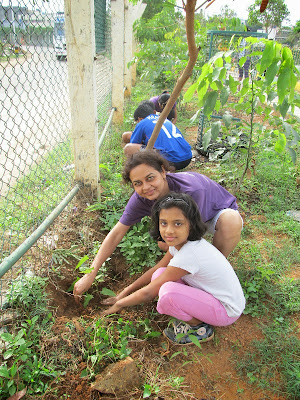The heavy rains on 31st May – 1st June helped raise the water level in several parts of Puttenahalli Lake by upto about 16 inches. With this about 65-75% of the lake bed is under water. We’re waiting for a few more similar downpours to bring the level higher.

The Lake, 1st June 2013 (Pic: Usha Rajagopalan)
The rains also cooled the place making the gardening weekend thoroughly enjoyable for all the volunteers. Over the two mornings, starting at 7 a.m., about 50 people coming from various parts of the city, helped in digging pits, planting shrubs, cleaning (plastics and other litter) and deweeding (mostly parthenium and other weeds). Thanks to Surendran, Founder, Volunteer For a Cause (VFC), we had volunteers from as far as Kodigehalli (beyond Whitefield), Marathahalli, BTM Layout, Banasankari, JP Nagar, in addition to friends from the lake neighbourhood. Several children who came with their parents got a live lesson in nature conservation. Together they managed to plant the 300+ butterfly attracting plants such as Hamelia patens, powder puff, ixora, cup & saucer, nerium oleander, plumbago and lantana that PNLIT had procured. These shrubs, planted adjacent to the water body will be maintained to a height of about 3 feet in order to deter people from entering the water.
With many of the volunteers asking for more work at the lake, we intend to have another planting session next weekend, weather permitting. Watch this space.
⊕







Great work